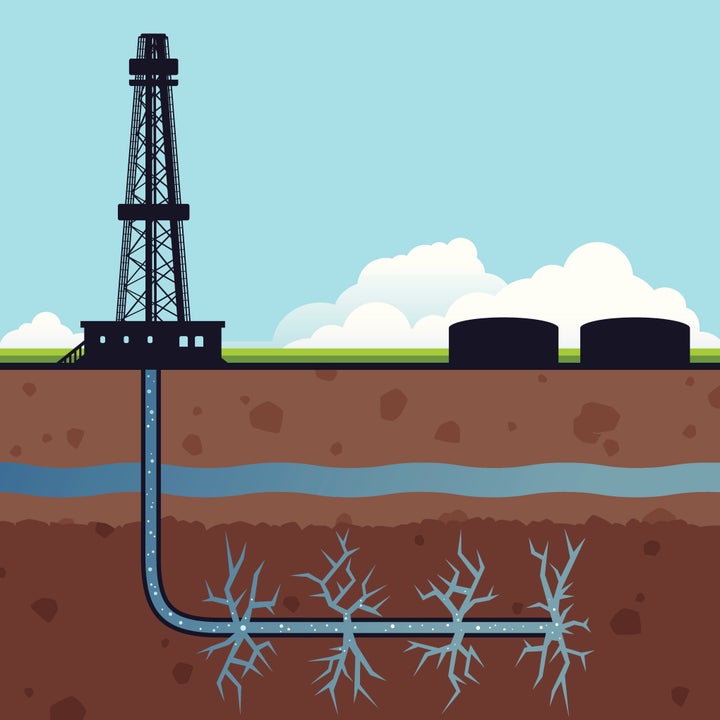
Prenatal exposure to a cocktail of chemicals commonly used in the various phases of oil and natural gas production, including fracking, could carry long-term reproductive health consequences, according to a new study published on Wednesday.
Scientists tested 24 fracking chemicals -- including benzene, toluene and bisphenol A -- and found that 23 of them could mimic and mess with the natural signaling of estrogens, androgens and other human hormones, including functions critical for the healthy development of sex organs and future fertility. Researchers found that male mice exposed in the womb to minute levels of the mixture developed enlarged testes and decreased sperm counts later in life.
The concentrations represent potentially realistic levels of human exposure via drinking water, according to Susan Nagel, an author of the study and an expert in reproductive and environmental health at the University of Missouri.
"Bottom line, hormones work at very low concentrations naturally," Nagel told The Huffington Post. "It does not take a huge amount of a chemical to disrupt the endocrine system."
Hormone-disrupting chemicals have become the subject of increasing scientific scrutiny. In a statement published last month, the Endocrine Society, a professional medical organization, described the potentially widespread health threats posed by the class of chemicals. Even at very small concentrations -- say, a couple of tablespoons in an Olympic-size swimming pool -- exposures to these chemicals early in life have been shown capable of derailing normal brain and sexual development, diminishing the immune system's ability to fight disease, among other effects. Combine these chemicals, the society warned, and the risks may become all the more unpredictable and worrisome -- and potentially costly. An analysis published in March attributed more than $200 billion a year in health care expenses and lost earning potential to hormone-disruptor exposures in the European Union.
"We can't dismiss chemicals that we detect in our food or water just because they are at low doses," said Andrea Gore, a hormone disruptor expert at the University of Texas at Austin.
Gore, who is also editor-in-chief of Endocrinology, the journal in which the new study appears, suggested the findings fit an emerging pattern. In addition to reproductive health problems, scientists have increasingly found links between exposure to hormone disruptors -- which are also commonly found in plastics, herbicides, nonstick fry pans and other consumer goods -- and health issues like obesity, diabetes and breast cancer.
"During development, there are so many developmental processes -- structures and organization of different organs that are set up," she said. "If that gets perturbed, then an organ can really be deficient."
The boom in the extraction of oil and natural gas has continued across large swaths of the U.S. this year, even inspiring a new primetime television show. Fracking companies use a mix of pressurized water, sand and chemicals to unlock hydrocarbon reserves deep in shale rock. Among the approximately 1,000 different chemicals known to be used in these operations, the study authors report, at least 100 could potentially interfere with the natural hormone messengers in the body.

The oil and natural gas production industry, however, maintains that the processes involved in its operations are safe. Industry representatives were critical of the new research.
"This study presents the most unlikely scenario in order to suggest the worst possible health outcomes," Katie Brown, a spokeswoman for Energy in Depth, the oil and gas industry's education and public outreach arm, told HuffPost in an emailed statement. "The researchers manufactured a concoction of far more chemicals than are even used during fracking, and at far higher doses."
Nagel acknowledged that the highest of the four concentrations her team added to the drinking water of pregnant lab mice -- a level that mimicked the concentrations found in fracking wastewater from some Colorado drilling sites -- was unlikely to represent realistic human exposures. But she suggested that the bottom two doses could, in fact, be relevant based on their estimates.
What's more, Nagel and her team found that in some cases, exposures to those lower concentrations actually resulted in greater effects than the higher concentrations. This phenomenon, where minute amounts of a chemical prove more potent than larger quantities, continues to crop up in research on this class of chemicals. Researchers are finding that the dose does not always make the poison -- at least not in the ordinary sense. Yet the traditional dose-response assumption remains the basis for most regulatory tests.
In her email, Brown also highlighted the Environmental Protection Agency's long-awaited investigation into the potential effects of fracking, released in June. The agency found "no evidence of widespread water contamination," she pointed out, and any issues the EPA did find were "isolated and small compared to the total number of wells drilled."
As Factcheck.org pointed out after the report's release, an EPA official noted that the report makes no determination of safety and, in fact, points to some specific cases of water contamination. Both sides, according to Factcheck.org, are guilty of misrepresenting the study's findings. The true extent to which fracking can contaminate drinking water with chemicals such as these hormone disruptors remains unclear.
In July, a California panel concluded that because of data gaps and inadequate testing, the true impacts of the fracking process are still mostly unknown. The panel left open the possibility that the toxic chemicals used could contaminate drinking water.
Fracking companies are not required to disclose all of the chemicals they use in their operations. A controversial exemption from existing environmental regulations, known as the "Halliburton loophole," continues to make it difficult to monitor fracking activities, let alone prove any links to health problems.
Despite the roadblocks to research, findings on the subject continue to mount. A study published in March 2014 found that pregnant women who lived near fracking wells faced an increased risk of giving birth to children with health issues such as oral clefts and heart problems. Another paper by Nagel's team, published in December, suggested that tiny doses of chemicals released during oil and natural gas production could pose serious health risks to developing fetuses, babies and young children.
More recently, in September, researchers reported findings of a 40 percent increased risk of preterm birth for babies of expectant parents living nearest to fracking operations in Pennsylvania.
Brian Schwartz, lead author of that study and an environmental health researcher at Johns Hopkins Bloomberg School of Public Health, called Nagel's new findings "interesting, important and potentially relevant." But he, too, cautioned against inferring too much when it's not clear whether the doses fed to the mice truly reflect the levels at which people may be exposed.
Nagel and Gore both emphasized the need for further research into various levels and routes of exposure -- from air pollution to drinking water -- as well as other potential hormone-disrupting effects.
What the new study uncovered for male reproductive health, said Gore, "may only be the tip of the iceberg."
